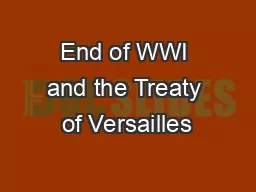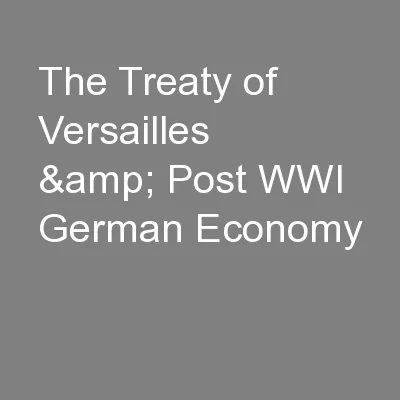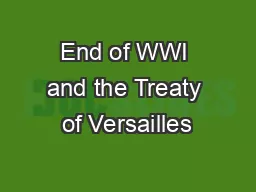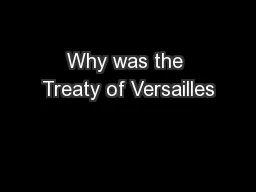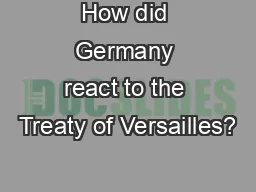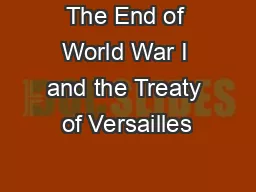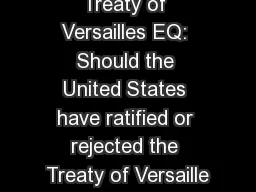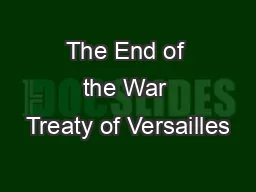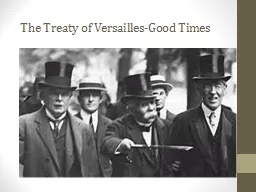PPT-End of WWI and the Treaty of Versailles
Author : danika-pritchard | Published Date : 2017-05-25
End of the War November 11 1918 11 th month 11 th day 11 th hour agree to an armistice a cease fire Now celebrated as Veterans Day Wilson gave workers the day
Presentation Embed Code
Download Presentation
Download Presentation The PPT/PDF document "End of WWI and the Treaty of Versailles" is the property of its rightful owner. Permission is granted to download and print the materials on this website for personal, non-commercial use only, and to display it on your personal computer provided you do not modify the materials and that you retain all copyright notices contained in the materials. By downloading content from our website, you accept the terms of this agreement.
End of WWI and the Treaty of Versailles: Transcript
End of the War November 11 1918 11 th month 11 th day 11 th hour agree to an armistice a cease fire Now celebrated as Veterans Day Wilson gave workers the day off Kaiser was en route to exile in the Netherlands. Map 25.5: Europe in 1919. Treaty of Versailles. Used Wilson’s 14 Points. Big 3 + Italy (Big Four). Did not agree on goals for the peace talks. The Big Four. Woodrow Wilson USA. David Lloyd-George Great Britain. Woodrow . Wilson's Fourteen . Points:. #. 1. -4 Free economy, transparency, and arms reduction . Open covenants of peace, openly arrived at.. Freedom of navigation on the seas.. Removal of economic barriers and equality of trade conditions.. Further Demoralization and Defeat. World War I (1914-1918). Germany’s defeat is made official on Armistice Day, November 11, 1928. The Treaty of Versailles June 28, 1919. Established the peace terms and signed in Paris.. What happens when a war has just finished?. 11th . November 1918, 1100hrs - the war . is over!. . 7,849,000 soldiers lay dead in the fields of Europe - a generation wiped out by bomb, bullet and gas.. 1. Please take a handout on your way in.. Totalitarianism. : . When . government power is total and absolute; . C. omes . during bad times. .. Italy:. Totalitarian government called Fascism. Benito Mussolini. End of the War. November 11, 1918 (11. th. month, 11. th. day, 11. th. hour) – agree to an armistice – a cease fire. Now celebrated as Veteran’s Day. Wilson gave workers the day off. Kaiser was en route to exile in the Netherlands. so unpopular . in Germany?. L/O – To evaluate the terms. . of the . ToV. and to identify its effects upon the Weimar Republic. Philipp . Scheidemann. . who was the German Chancellor in June 1919 resigned rather than sign the treaty, saying,. Pop Quiz for Candy!. What were the MAIN causes of WWI?. What was the spark that started WWI?. What countries were in the Triple Alliance?. What countries were in the Triple Entente?. By the end of the war, what countries had joined the Allied powers? (Besides the original 3). L/O: To be able to analyse sources in order to explain how Germany reacted to the Treat of Versailles.. G. A. R. G. L. E. The Treaty of Versailles – GARGLE!. Guilt. – Germany accepted full blame for the war. Objective: Analyze the effects of WWI with . e. mphasis on the Treaty of Versailles and the League of Nations.. Summarize the Treaty of Versailles. War-guilt clause. : blamed Germany for causing the war. WWI: 1914-1918. Treaty of Versailles: 1919. The Outcome. 22 million civilians and soldiers were killed. The Allied Forces won and blamed Germany for much of the killing and damage during the war. In 1919, Germany was forced to sign the . How do you feel about President Wilson traveling to the peace conference in France?. What hopes do you have?. What fears concern you?. Imagine that it is 1919. You are an American who has just opened up the morning newspaper. You see this photograph. In your notebook, respond to these questions:. Casualties. Examine the number of casualties between each of the countries involved:. http://www.spartacus.schoolnet.co.uk/FWWdeaths.htm. Destruction. Destruction. Destruction. Destruction. The Village of . .. Pre-Versailles Germany – not good times. By 1918 the average German was living on 1000 calories a day---1/2 the amount needed for a normal diet. Coal was in short supply, gas was non-existent, and electricity was nowhere to be found.
Download Document
Here is the link to download the presentation.
"End of WWI and the Treaty of Versailles"The content belongs to its owner. You may download and print it for personal use, without modification, and keep all copyright notices. By downloading, you agree to these terms.
Related Documents

